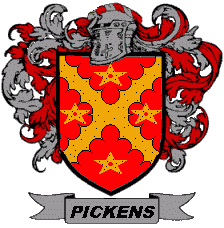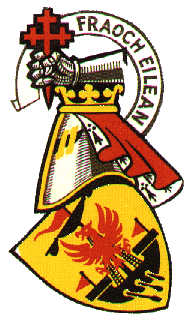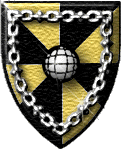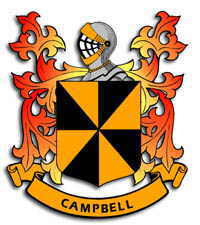


Clans of the Pickens Family

========================
Clan MacDonald (of Sleat)

Official Crest of Macdonald of Sleat
Gaelic Name: MacDhomhnuill
Motto: Per mare pre terras
(By sea and by land)
Badge: Heather
Lands: Western Isles
Origin of Name: Gaelic, Domhnull (World ruler)
Beginnings:
Magnus Barefoot, the King of Norway, sailed across the
North Sea in 1098 to re-establish his country’s power
in Celtic lands. He made an agreement with Edgar,
King of Scots, that he would settle for all the islands
of the west coast he could reach whilst his boat’s rudder
was in a fixed position.
It is difficult in a short sketch to outline the history of various
branches of the clan Donald, the families of which are intricately
interwoven. Somerled, Regulus of the Isles, from whom the clan trace
their descent, expelled the Norsemen from the Western Isles in the
12th century. He was killed at Renfrew in 1164 when his army did
battle with Malcolm IV, and was succeeded by his son Reginald,
Lord of the Isles, from whom are descended the Clans MacDonald
and MacRurie.
From Dugall, the brother of Reginald, are descended the Clan
MacDugall. Reginald was liberal to the church and founded the
monastery of Saddell. His son, Donald "de Isla," succeeded him,
and under his guidance the clan attained great eminence. He died
in 1269 and was succeeded by his son Angus who supported Haco, but
did not suffer from the latter's defeat at Largs in 1263. Angus
Og supported Bruce and increased the family possessions considerably.
His son, John, assumed the title of Lord of the Isles in 1354. His
son Donald of Harlow followed as 2nd Lord of the Isles.
He married the only daughter of the Countess of Ross, and claimed
the Earldom of Ross, but later renounced this claim and became a
vassal of the crown. He died in 1423, and his son Alexander succeeded
and became Earl of Ross on the death of his mother. The title was
acknowledged by the Crown in 1430. For a period he was Justiciar
of Scotland. He died in 1448 and was succeeded by his son John,
4th and last Lord of the Isles, who rebelled against the Crown
and declared his independence. After a long stormy life, during
which the Earldom of Ross was annexed to the crown, And the Lordship
of the Isles forfeited, John died without legitimate issue in 1498.
The strength of the Macdonalds has at all times been considerable.
In 1427, the Macdonnells of Garmoran and Lochaber mustered 2000 men:
in 1715, the whole clan furnished 2820; and in 1745, 2330. In a
memorial drawn up by President Forbes of Culloden, and transmitted
to the government soon after the insurrection in 1745, the force of
every clan is detailed, according to the best information which the
author of the report could procure at the time. This numeration,
which proceeds upon the supposition that the chieftain calculated on
the military services of the youthful, the most hardy, and the bravest
of his followers, omitting those who, from advanced age, tender years,
or natural debility, were unable to carry arms, gives the following
statement of the respective forces of the different branches of the
Macdonalds. Macdonald of Sleat / 700
Macdonald of Clanranald / 700
Macdonnell of Glengarry / 500
Macdonnell of Keppoch / 300
Macdonald of Glencoe / 130
____________________
In all / 2330
Next to the Campbells, therefore, who could muster about 5000 men,
the Macdonalds were by far the most numerous and powerful clan in the
Highlands of Scotland.
========================
Clan Campbell of Argyll

Official Crest of all Campbell Societies

Official Campbell of Argyll Crest
Gaelic Name: Caimbeul
Motto: Na obliviscaris
Badge: Wild Myrtle, Fir Club Moss
Lands: Argyll
Origin of Name: Gaelic, Camshron from ‘Cam’ (wry) and ‘Beul’ (mouth)
Beginnings:
The name Campbell seems to come from the Gaelic Cam Beul, which
translates as Crooked Mouth. The users of this name are known
to have been around as a powerful family even in the time of
the ancient kingdom of Dalriada, though the earliest Campbell to be
found in written records is Gillespie of east-central Scotland,
who had lands in this area granted to him in 1263.
Clan Campbell facts.
========================
Clan Bruce

Official Bruce Crest
Gaelic Name: Brus
Motto: Fuimus (We have been)
Arms: Bruce, Earl of Elgin*
Badge: A lion statant with tail extended, azure, armed and langued gules.*
Branches: Airth, Clackmannan, Kennet, Kinnaird.
Tartans: Bruce, Bruce of Kinnaird
Plant Badge: Rosemary
Lands:
Origin of Name: from French town of Brix
Septs: Carlyle, Carruthers, Crosbie, Randolph, Stenhouse.
Beginnings:
Note:*The Crest and Arms belong to the Chief and can only be used by him. Use of the
Crest surrounded by a buckled belt is acceptable.
This name, now inextricably linked with the history of the Scottish nation through
its association with the victor of
Bannockburn, was ancient long before that momentous battle.
Map of the battle of Bannockburn.
It is believed that Adam de Brus built the castle at Brix between Cherbourg
and Valognes in Normandy in the eleventh century, the ruins of which still remain.
Robert de Brus followed William the Conqueror, Duke of Normandy, to England in 1066,
and although he is thought to have died soon after, his sons acquired great possessions
in Surrey and Dorset. Another Robert de Brus bacame a companion-in-arms to Prince
David, afterwards David I of Scotland, and followed him when he went north to regain
his kingdom in 1124. His loyalties were torn in 1138 when, during the civil war in
England between Stephen and Matilda, who claimed to be the rightful heiress, David
led a force into England. de Brus could not support his king, and resigned his holdings
in Annandale to his second son, Robert, to join the English forces gathering to resist
the Scottish invasion. At the Battle of the Standard in 1138, Scottish forces were
defeated and de Brus took prisoner his own son, now Lord of the lands of Annandale.
He was ultimately returned to Scotland, and to demonstrate his determination to
establish his branch of the family in Scotland, he abandoned his father's arms of
a red lion on a silver field and assumed the now familiar red saltire. The arms
borne by the present chief allude to both elements.
William the Lion confirmed
to the son the grant of the lands of Annandale made to his father by David I.
Robert, fourth Lord of Annandale, laid the foundation of the royal house of Bruce
when he married Isobel, niece of William the Lion. She also brought extensive
estates, both in Scotland and England.
Princess Isobel's son, another Robert,
known as 'the competitor', was at the time named heir to the Scottish crown.
However, his claim was challenged by the birth of a son to the daughter of his
wife's elder sister, who was married to John Balliol. On the death of Alexander III
in 1286 there commenced the contest for the succession to the Crown between Bruce
and Balliol. The death of the child heir to the throne,, Margaret, the maid of Norway,
in 1290, opened the competition for the succession once more, and to avoid a civil war,
the rival claimants asked Edward I of England to act as arbiter. In 1292 Edward found
in favour of John Balliol. But Edward was not content to advise on the selection of
the new monarch, and asserted a right of overlordship in Scottish affairs. Balliol
attempted armed resistance but was decisively defeated at the Battle of Dunbar in
1296. His defeat left the leadership of Scotland in the hands either of the powerful
Comyn family or the Bruces.
Robert the Bruce met John Comyn in February 1306 in the
Church of the Minorite Friars at Dumfries. Bruce stabbed his rival in the heart,
and his companions dispatched the rest of the Comyn party. Within weeks Robert was
crowned King and began a long, hard campaign to make his title a reality, culminating
in the Battle of Bannockburn in 1314. He set about rebuilding the shattered nation
and it is a considerable tribute to his leadership and abilities that he substantially
achieved his objectives. In 1370 the first Stewart monarch succeeded to the throne by
right of descent from Marjory, Bruce's daughter.
Thomas Bruce, who later claimed close kinship with the royal house, organised with Robert
the Steward (later Robert II) a rising in Kyle against the English in 1334. He received
in recompense part of the Crown lands of Clackmannan.
Sir Edward Bruce was made commendator of Kinloss Abbey and appointed judge in 1597.
In 1601 he was appointed a Lord of Parliament with the title of "Lord Kinloss".
He accompanied JamesVI to claim his english throne in 1603 and was subsequently
appointed to English judicial office as Master of the Rolls. In May 1608 he was
granted a barony as Lord Bruce of Kinloss. His son, Thomas, was created first earl
of Elgin in 1633. The fourth Earl died without a male heir and the title passed to
a descendant of Sir George Bruce of Carnock, this branch of the family had already
been created Earls of Kincardine in 1647, and thus two titles were united.
The seventh Earl of Elgin was the famous diplomat who spent much of his fortune
ressuing the marbles of the Parthenon which were at that time falling into utter ruin.
His son was an eminent diplomat and Governor General of Canada. He led two important
missions to the Emperor of China. He was Viceroy of India, a post also held by the
ninth Earl of Elgin from 1894-1899.
The present Chief- the eleventh Earl of Elgin and fifteenth of Kincardine- is prominent
in Scottish public affairs and is convener of the Standing Council of Scottish Chiefs.

Back to my PICKENS home page.








